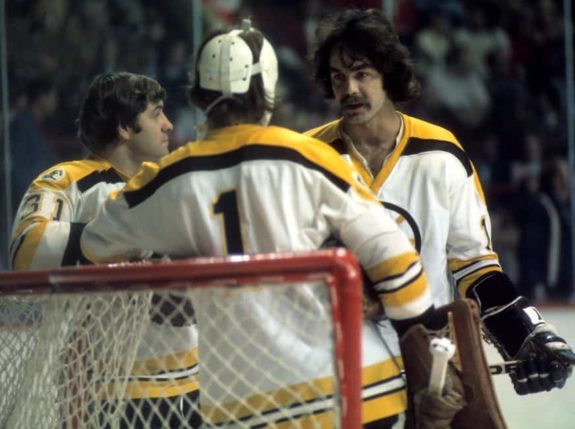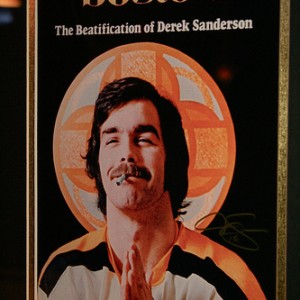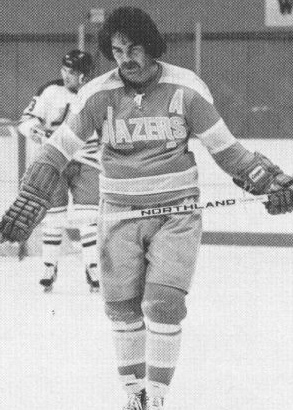Combine a gritty style of play with quick hands and fast feet, throw in a swagger that sat well with his movie-star good looks, mix well with his fair share of nastiness and you have the young Derek Sanderson, better known by his friends and teammates as “Turk”.
Born and raised in Niagara Falls, Ontario, he played his junior hockey for the N.F. Flyers. In 1965 Turk led his team to the Memorial Cup, symbol of junior hockey supremacy in Canada and in 1967 he was the recipient of the Eddie Powers Memorial Trophy as the OHL’s leading scorer.

Instinctively, Derek always understood the value of “the big stage.” In 1966, the Boston Bruins management, in the middle of a cellar-dwelling season, decided to arrange a game in the Boston Garden between the Sanderson-led Niagara Falls Flyers and the Bobby Orr-led Oshawa Generals to showcase their up and coming talent. Winning that night was not Sanderson’s agenda; enticing Orr into a brawl was. The scouts and the fans took note. A year later the two budding superstars were teammates on the Bruins.
Calder Trophy, Stanley Cup and Trouble
Playing with the Bruins in 1967-68, he scored 24 goals with 25 assists and won the Calder Trophy as Rookie of the Year.
Despite playing with a Hall-of Fame lineup in Bobby Orr, Phil Esposito, Gerry Cheevers and Ed Westfall,

Turk became a fan favorite and to many the most exciting player on the ice; with him on the ice you never knew what would happen next.
Those early years in Boston were the apex of his life. Fame and fortune had come his way. He drove a silver Rolls Royce, owned a nightclub, Bachelors Three, in New York and Boston in partnership with Joe Namath and could make quite an entrance with his full-length mink coat and a new blonde on his arm every night.
Probably the most famous goal in hockey history is the winning tally in the 1970 Bruins Stanley Cup final game. The image of Bobby Orr flying though the air after whipping the puck past St. Louis goalie Glenn Hall in indelibly etched in the minds of most hockey fans, Bruin supporter or not. That perfect pass, zipped from behind the goal line that set Orr up, was from Derek Sanderson. (See video)
“I made the kid famous,” he joked.
Sanderson to the upstart WHA
After winning a second Stanley Cup two years later, Boston fans could not believe the news that summer that Sanderson had jumped to the upstart WHA, signing with the Philadelphia Blazers for $2.6 million. His new deal, that the Bruins would not match, made him the highest paid athlete in the world at that time. Derek did know how to grab a headline.
Opening night in Philadelphia, there was a problem with the ice and pucks kept disappearing under the boards. The referees were obliged to cancel the game. As captain of the Blazers, Derek felt a responsibility to explain the situation to the fans. As a promotion, the club had given each patron in attendance a souvenir orange puck. As he started his speech at center ice, one puck was tossed in his direction in protest of the cancellation. Before long, pucks were raining down and Captain Derek had to beat a hasty retreat to the dressing room to save his skin.
Unfortunately, the Philadelphia sortie did not have a happy ending. A serious knee injury

six games into the season laid him up indefinitely. A few smart-alec quotes in the press made his new owners irate and, before the season was over, the team bought him out for $1 million. While his rights reverted to the Bruins, they traded him at the end of the season to the New York Rangers.
Derek’s off-ice troubles with alcohol and drugs were chipping away at his on-ice talents. Slowly he lost the magic and for several years after he left hockey, he struggled with those addictions. His lifestyle eventually left him penniless. In 1980, through the good graces of Bobby Orr, he checked into rehab in Ste. Catherine’s Ontario, and he has been sober ever since.
The Bruins’ organization, fans and former teammates rallied around a rehabbed Sanderson and NESN hired him as a color man on its hockey broadcasts For ten years he worked as a sidekick and color commentator for Fred Cusick, the Bruins play-by-play guy. After his broadcasting career, he went to work as a financial adviser to young hockey players who might experience the same dilemmas he did when the “too much, too soon” syndrome hit.
Boston fans remember him fondly. Turk always came to play, night after night. He was tough as nails. He and Ed Westfall were considered the best penalty-kill pair in his era. His fights were as legendary as his charm, while his smothering fore-checks and tenacity in the corners were his trademarks. On the ice, he did it all.
Derek Sanderson was truly one-of-a-kind.
** originally published in July 2010

Check this out Bruins fans!
Bobby Orr Famous Goal; May 10, 1970
Derek Sanderson Jeter of the new york yankees is named for the turk